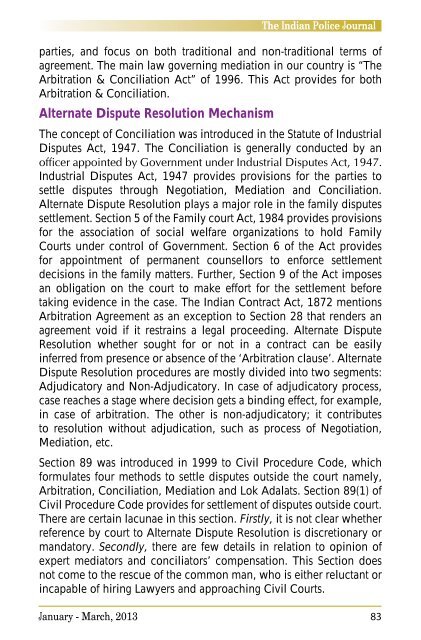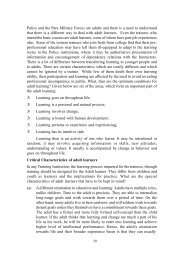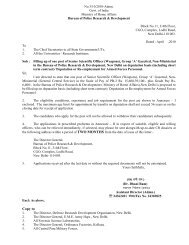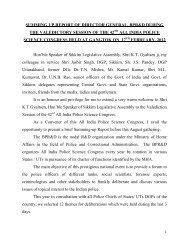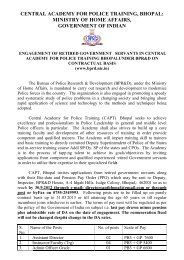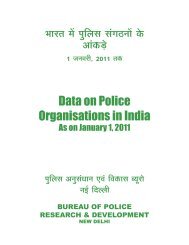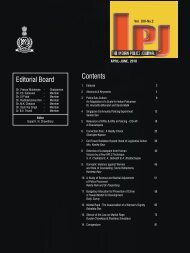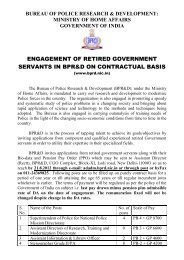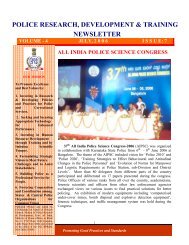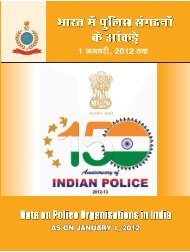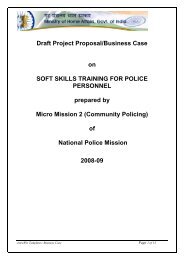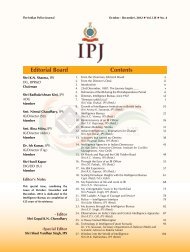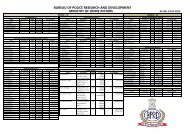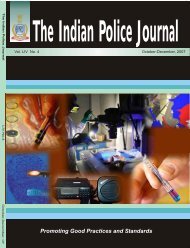by Police - Bureau of Police Research and Development
by Police - Bureau of Police Research and Development
by Police - Bureau of Police Research and Development
Create successful ePaper yourself
Turn your PDF publications into a flip-book with our unique Google optimized e-Paper software.
The Indian <strong>Police</strong> Journalparties, <strong>and</strong> focus on both traditional <strong>and</strong> non-traditional terms <strong>of</strong>agreement. The main law governing mediation in our country is “TheArbitration & Conciliation Act” <strong>of</strong> 1996. This Act provides for bothArbitration & Conciliation.Alternate Dispute Resolution MechanismThe concept <strong>of</strong> Conciliation was introduced in the Statute <strong>of</strong> IndustrialDisputes Act, 1947. The Conciliation is generally conducted <strong>by</strong> anIndustrial Disputes Act, 1947 provides provisions for the parties tosettle disputes through Negotiation, Mediation <strong>and</strong> Conciliation.Alternate Dispute Resolution plays a major role in the family disputessettlement. Section 5 <strong>of</strong> the Family court Act, 1984 provides provisionsfor the association <strong>of</strong> social welfare organizations to hold FamilyCourts under control <strong>of</strong> Government. Section 6 <strong>of</strong> the Act providesfor appointment <strong>of</strong> permanent counsellors to enforce settlementdecisions in the family matters. Further, Section 9 <strong>of</strong> the Act imposesan obligation on the court to make effort for the settlement beforetaking evidence in the case. The Indian Contract Act, 1872 mentionsArbitration Agreement as an exception to Section 28 that renders anagreement void if it restrains a legal proceeding. Alternate DisputeResolution whether sought for or not in a contract can be easilyinferred from presence or absence <strong>of</strong> the ‘Arbitration clause’. AlternateDispute Resolution procedures are mostly divided into two segments:Adjudicatory <strong>and</strong> Non-Adjudicatory. In case <strong>of</strong> adjudicatory process,case reaches a stage where decision gets a binding effect, for example,in case <strong>of</strong> arbitration. The other is non-adjudicatory; it contributesto resolution without adjudication, such as process <strong>of</strong> Negotiation,Mediation, etc.Section 89 was introduced in 1999 to Civil Procedure Code, whichformulates four methods to settle disputes outside the court namely,Arbitration, Conciliation, Mediation <strong>and</strong> Lok Adalats. Section 89(1) <strong>of</strong>Civil Procedure Code provides for settlement <strong>of</strong> disputes outside court.There are certain lacunae in this section. Firstly, it is not clear whetherreference <strong>by</strong> court to Alternate Dispute Resolution is discretionary orm<strong>and</strong>atory. Secondly, there are few details in relation to opinion <strong>of</strong>expert mediators <strong>and</strong> conciliators’ compensation. This Section doesnot come to the rescue <strong>of</strong> the common man, who is either reluctant orincapable <strong>of</strong> hiring Lawyers <strong>and</strong> approaching Civil Courts.January - March, 201383


